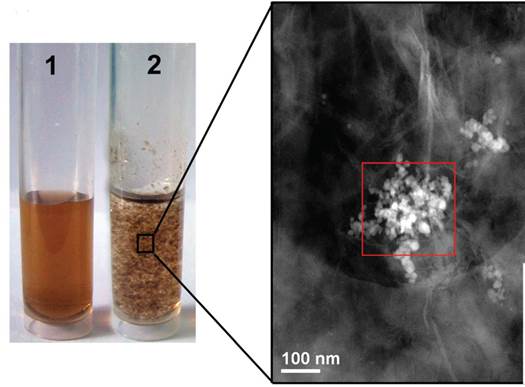Graphene oxide rapidly removes some of the most toxic long-lived human-made radioactive nuclides from contaminated water Dr. Mae-Wan Ho
Among the worst legacy of nuclear power industry is the huge amount of long-lived radioactive wastes generated that contaminate land and water, among which the transuranic elements – elements with atomic numbers greater than 92 (that of uranium) - are the most toxic. The recent accident at the Fukushima Daiichi nuclear power plant released enormous quantities of radionuclides to the environment, including contaminated cooling water, rivalling if not exceeding the Chernobyl fallout. The latter has continued to contaminate soil, sediment and groundwater, with devastating health impacts still unfolding through the years and down the generations (see [1] Death Camp Fukushima Chernobyl - an ISIS special report, SiS 55). Naturally occurring radionuclides are also brought up in fracking fluids (see [2] Fracking for Shale Gas, SiS 57), and exposed as the result of mining operations. Effective treatment and decontamination measures are sorely needed.
Researchers led by Stepan Kalmykov at Moscow State University in Russia and James Tour at Rice University Houston, Texas in the US may have found the perfect solution for nuclear decontamination in graphene oxide [3, 4]. The carbon allotropes fullerenes, carbon nanotubes, nanodiamonds and graphene have received a lot of attention lately in nuclear waste management. Graphene oxide, however, has been relatively neglected, except as an intermediate to making graphene by chemical exfoliation from graphite. But graphene oxide has proven to be non-toxic and biodegradable, and could be produced in bulk in an environmentally safe manner. It is soluble in water and forms stable colloid suspensions when dispersed in other liquids because of its amphiphilic (able to mix with water or oil) character. Graphene oxide dispersed in liquids also show excellent sorption capacities. Previously, it was shown to remove Cu (copper), Co (cobalt), Cd (cadmium), Eu (europium), arsenate, as well as organic solvents.
The surface of graphene oxide is covered with epoxy, hydroxyl, and carboxyl groups that are well-suited for interacting with cations and anions. Not surprising, it turns out to be very good at removing radioactive nuclides from water. The researchers focussed on radioactive isotopes of actinides (the group of elements with atomic numbers 89 to 103 to which the radionuclides Th (thorium), U (uranium), Np (neptunium), Pu (plutonium), and Am (americium) belong) and lathanides (the group ‘rare earths’ with atomic numbers 57 to 71, to which Eu belongs).
The action of graphene oxide is dramatic. Even at very low concentrations < 0.1 g/L, the sorption of radionuclides is complete within 5 minutes. Graphene oxide removes 95 % or more of Pu, Am, and Th and ~55 % of U at around pH 3.5. At higher pH between 4 and 8, over 90 % of all the nuclides are removed, including U and Eu. At still higher pH (>7), more than 70 % of Sr (strontium ) and Tc (technicium) are removed and up to 20 % of Np. The sorption is reversible for Pu and U by lowering the pH.
The removal of radionuclides from waste solutions was tested using simulated liquid nuclear wastes that contain U and Pu, together with Na (sodium), Ca (calcium) and various substances such as carbonate, sulphate, acetate and citrate that could potentially compete with the sorption process, as actinides form strong complexes with them.
When the graphene oxide was added to the simulated nuclear waste solution, coagulation occurred almost immediately (see Figure 2). The nanoparticles form aggregates that can be seen on scanning transmission electron microscopy (Fig. 2 right), and were confirmed to contain the radionuclides on energy-dispersive X-ray spectroscopy.

Figure 2 Clear solution of graphene oxide in water (test tube 1) and coagulated complexes of graphene oxide with bound radionuclides in the simulated nuclear waste solution (test tube 2); right scanning transmission electron microscope image showing the formation of nanoparticles aggregate containing radionuclides from the coagulated simulated nuclear waste solution
The critical coagulation concentration of graphene oxide with different cations depends on the cation charge, and is hence affected by the pH. Coagulation is driven by sorption and is likely to be followed by bridge formation between sheets of graphene oxide, thereby inducing the coagulation.
Graphene oxide has a high sorption affinity for the most toxic radionuclides. It is much more nuclear wastes. The graphene oxide-nuclide complexes could be easily coagulated and precipitated out.
The process can be readily scaled up, making graphene oxide a very promising new material for radionuclide containment and removal not only in the nuclear power industry, but also in the mining industry. The high sorption rates indicate strong binding, and can greatly simplify implementation of clean-up methods. The environmental safety and biodegradability of graphene oxide also allows in situ clean-up approaches.
Article first published 17/07/13
Comments are now closed for this article
There are 2 comments on this article.
thorfourwinds Comment left 29th October 2013 17:05:14
Greetings:
We are interested in communicating with anyone who is involved (or would like to be) with transmutation, removal or dilution of radioactive nuclear waste, starting with Fukushima. We are currently investigating John Hutchison's 'Ray Gun' claims, as well as Tom Bearden's and Dr. Patrick Flanigan's relevant work.
Thank you for your time and consideration.
thorfourwinds
The World Must Take Charge at Fukushima
http://www.thelivingmoon.com/forum1/index.php?topic=5453.msg75886#msg75886
michael p. dunkailo Comment left 21st January 2014 19:07:45
I don't know much,but this sounds like it might help.Have also heard boron could help too.When will the goverments of the world will tell us the truth,come together and try to save whats left ?